When we hear “3D printed” we usually think of flimsy plastic, but Daniel Defense‘s new DD WAVE suppressor is made via a process called direct metal laser sintering. A thin layer of powdered metal is deposited — in this case, primarily Inconel — then a powerful laser sinters (melts/welds) specific parts of it to the previous layer. Thousands of layers later and the end result is a single, homogeneous piece of metal similar to what you’d end up with via investment casting. Except internal structures impossible to create in a cast or machined piece can be made via DMLS.
Unfortunately, I’m not exactly convinced the DD WAVE has taken full advantage of the freedom afforded by additive manufacturing to do crazy things inside the suppressor that you couldn’t otherwise manufacture. To spoil the review up front, its performance left me wanting.
It does have that unique, 3D printed look, with subtle visible cues that it was built layer-by-layer and that pebbled, sand-like texture on cross-layer angled areas. I actually dig the texture. It provides a matte look and a bit more grip than smooth tubing.
The DD WAVE QD ships with either a 5/8×24 or 1/2×28 brake, with additional brakes sold separately. These act as the quick detach mating surface for the suppressor. A spring-loaded collar with a tapered locking ring rotates separately from the suppressor body and clamps it down onto the brake’s taper mount section so it doesn’t work free from the coarse (and therefore, quick) threads.
Unfortunately, I obviously need more practice as the first thing I did was lock the suppressor onto the 5/8×24 brake so dang hard that I couldn’t get it apart again. Hopefully the guys at Silencer Shop, who loaned me this can to review, have a couple strap wrenches or other grip- and leverage-providing tools there (or are willing to red loctite the brake to a barrel), because I cranked on this mother with enough force to make a chiropractor smile and I’m thinking they may be one piece now.
Anyway, after effectively turning it into a direct thread can, I put it on my 300 Blackout SBR (8.3″ Ballistic Advantage BA Hanson barrel) and fired 10 rounds of Freedom Munitions HUSH subsonic ammo through it.
It was comfortable, quiet, and sounded decent overall if maybe a bit on the high-pitched side. When I went to take it off to swap it for my Dead Air Sandman Ti, looking to run them back-to-back a bunch of times to get a feel for how they compare, I was shocked by how hot it was. Too hot to hang onto, I had to touch it quick and hot potato the thing to get it off, dropping it onto the table as fast as possible.
Maybe my memory was tricking me? But after 10 rounds through the Sandman it turned out my past experiences were correct in the ol’ noggin. I could grip the Sandman firmly and leave my hand on there for a full Hail Mary before it became uncomfortable.
Of course, the heat thing isn’t necessarily meaningful. The DD WAVE is a stout can that’s rated for whatever you can throw at it, including full-auto fire. I just found it interesting how very quickly and thoroughly the WAVE got smokin’ hot.
What mattered more was sound, and the Sandman Ti was ever so slightly quieter and very slightly deeper-toned on subsonic ammo. For all practical purposes I’d be willing to call it a wash here, as the difference was barely detectable. Some of that, of course, is due to how loud the action is on an AR-15. If I were shooting 300 BLK through a bolt gun I believe the fact that the Sandman was quieter would have been clearer. But still minor.
Switching to supersonic ammo the sound level difference became more apparent. Still, we’re talking about a minor difference, but a difference nonetheless. One that was obvious enough without metering equipment to both me and Ron.
What was more obvious was the backpressure and resulting blowback. While the Sandman Ti is by no stretch of the imagination a low-backpressure suppressor, it causes less than the DD WAVE. I could definitely click my ODIN Works adjustable gas block down a couple clicks with the WAVE. Again, with the ability to “print” interesting internal structures inside the WAVE, I was disappointed to get so much gas to the eyes.
So…not my first choice on a 300 Blackout. As it stands today, if you must know, for 300 BLK use I’d buy a Q Half Nelson or Trash Panda above anything else I’ve played with.
Anyway, onto a bolt action .308. My CZ 557 Urban Counter Sniper, to be precise, with its 16″ barrel.
I shot it first with the Sandman Ti, using both Freedom Munitions Boar Buster 168 grain soft points and IMI 175 grain BTHP match. Cool. No issues. It’s four or so dBs this side of “hearing safe” on this short of a barrel, but it was comfortable to the ears and has a nice tone.
I’d happily hunt or “urban counter snipe” without ear protection with this setup without hesitation.
Not the case with the DD WAVE. I don’t know what it actually meters, but I do know you shouldn’t shoot it on a 16″ .308 without ear pro. It was just loud enough to ring my ears. Trusting the brand name and the size of the suppressor plus its recent and cutting edge manufacture, etc., was a mistake.
Donning ear pro and kicking myself for my stupidity, I sent more rounds downrange and we’re back to the heating up thing. The DD WAVE got really hot really fast and caused enough mirage to start messing with my sight picture. And I had a SHIELD RMS on the gun! Yeah, any suppressor is going to get hot and cause heat waves in the air that distort your view of the target, but this one gets there particularly fast.
While the Daniel Defense DD WAVE is cool, new, and unique, and I like how it looks, I don’t have much else positive to say about it. It isn’t a particularly quiet suppressor and, at 20.6 ounces with the 5/8×24 brake (my Sandman Ti is a quarter pound lighter at 16.8 ounces), it isn’t a lightweight one, either. And with an MSRP of $1,157, it’s also uniquely expensive.
If you ask me, and I suppose by reading this you sort of are, if a “full size” QD .30 cal can is on your list get a Thunder Chicken, an Ultra 7CB (or Ultra 9CB), a Sandman-L, or any number of other suppressors carried by Silencer Shop (and they’re happy to talk you through all of the options on the phone) instead.
Specifications: Daniel Defense DD WAVE QD
Length: 7.6″
Diameter: 1.5″
Weight: 17.2 oz (without brake)
Caliber Rating: Up to .300 Win Mag
Full-Auto Rated: Yes
MSRP: $1,157 (about $1,099 via Silencer Shop)
Ratings (out of five stars):
Overall * *
Three stars is average, and I don’t think the DD WAVE makes the cut. Even if it’s manufactured via the most cutting edge method possible, in this age of great silencers it isn’t quiet enough, isn’t light enough, has too much backpressure, and gets too hot too fast to keep up with its less expensive, better competition.

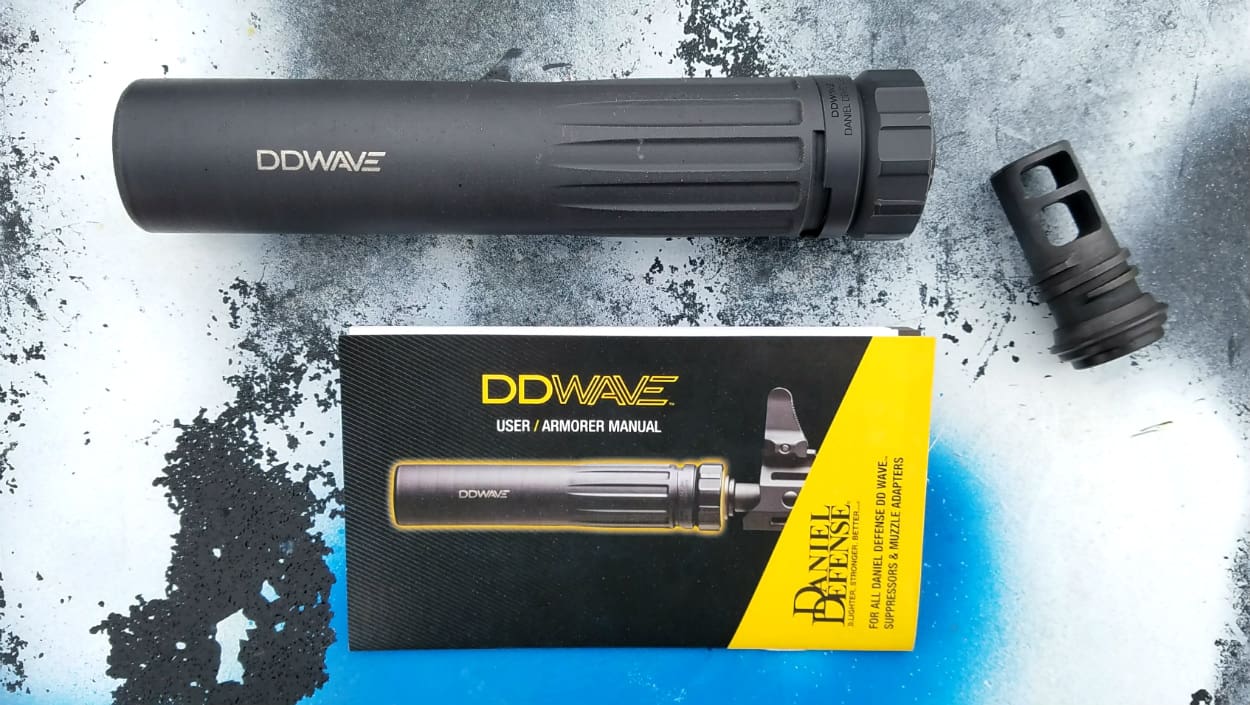
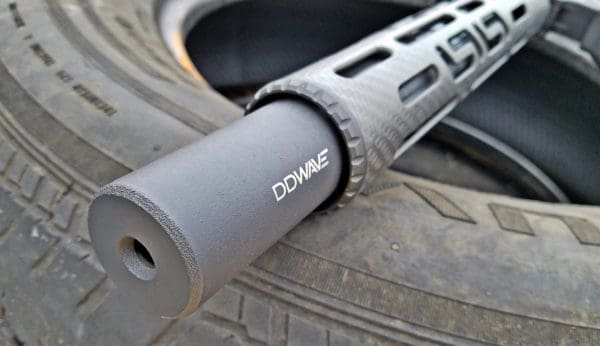


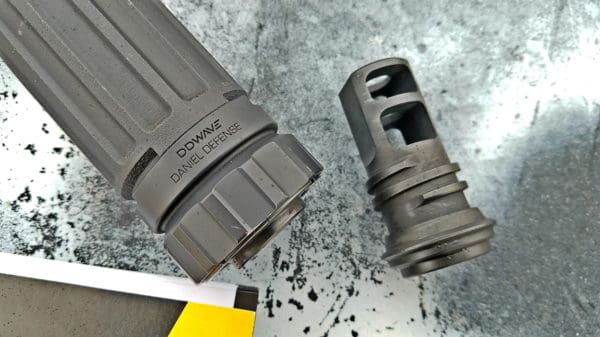
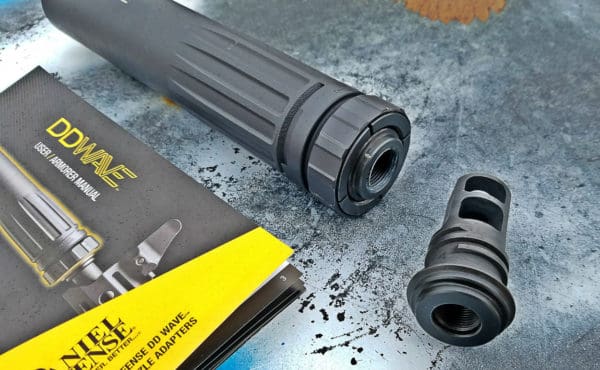
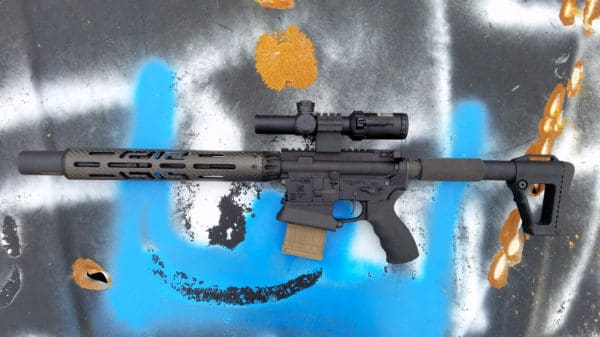
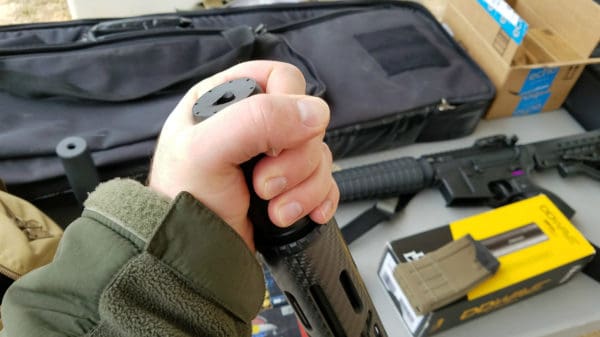
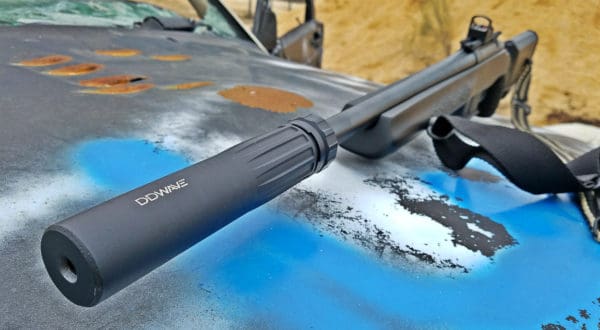
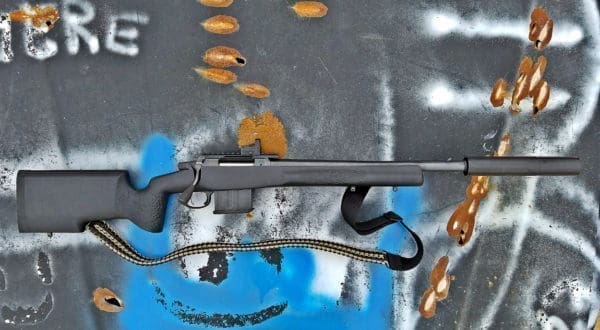
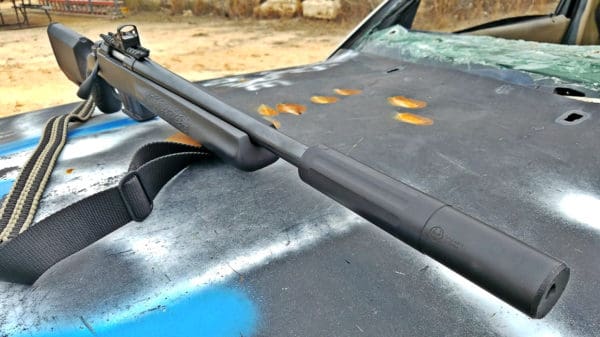
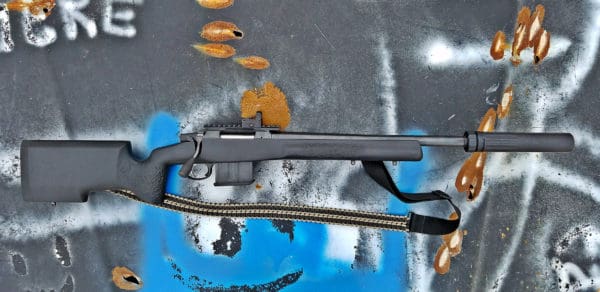
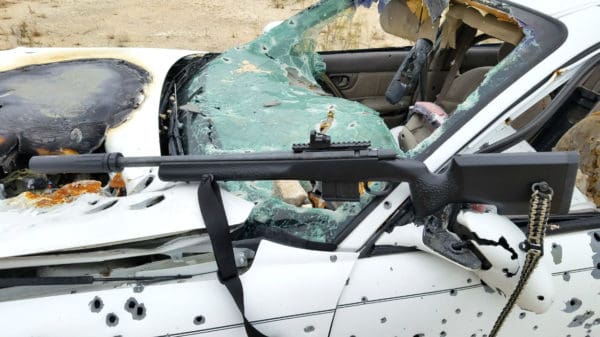
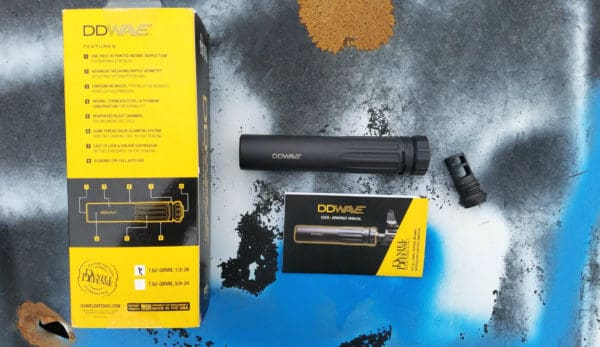



So, pretty much like the rest of their products. Overpriced for what you get.
After having seen the sausage being made, you’re exactly right…
Additive manufacture of metal items, especially when made using the sinter / powder process, can result in a structure that’s porous. Very strong, potentially … but porous. In this application, my first thought re the heating was that some of the gas was finding its way to the surface of the can, helping it to get hotter, faster, than it otherwise should. (Especially given it’s made of inconel.)
The other thing is that the interior geometry is going to be constrained by the ability to get the unsintered powder out of the body of the suppressor. You can make complex shapes, but not completely arbitrarily.
I brought up similar concerns among others earlier and was summarily ignored. It’s nice to see when people out of their field eat crow with the finished product.
Please explain the non-captive shapes that you cannot remove unsintered material out of with compressed air.
I’m very curious to hear what they are.
The simplest example (and a dumb one for this application, but one of the first additive manufactured things I’d ever seen) would be a round solid shell.
There are any number of shapes which, when made, are very hard to get material out of. Basically anything that recurves back on itself with small openings into a larger space – a mostly trapped volume with no through flow path.
Dang edit button…
And note I never said impossible, I said constrained. At some point it’s a matter of how much time, energy and complexity you want to spend on the finishing steps, vs the gain you get from the shape itself.
Couldn’t prior-layer(s) powder be blown off/out during the building process? You know, at certain stages before the part is complete, hit it with a jet of compressed air to clear dust out while it’s more easily clearable?
Jeremy: perhaps one of the newer powdered metal jet ones could; I’m not as familiar with them. The older style, not really, I think, as you need the powder to provide material, as well as support for layers not directly above the last one, and you want that layer to be as uniform as possible. A wire-fed version might avoid the problem entirely but the ones I’ve seen often require finish machining, which might or might not work for this application.
I suspect the manufacturing industry will come to optimize the use of additive, subtractive and forming techniques for a single product, either for lowest cost, highest strength, or whatever “best” you determine. But we’re still in the learning phase, both of additive manufacturing itself (powdered metals aren’t nice to work with) and how to best integrate it with existing techniques.
So please, do tell about these shapes. I’ve found that that in/compressible fluids will remove them all, especially in a CFD designed environment. It may take a second, you may have to design a delivery tool, but I have yet to see this unicorn.
Explain it to me so I can look for it.
16V: I usually see them referred to as reentrant (or highly reentrant) cavities. Some simple examples of cross-sections are here: https://ars.els-cdn.com/content/image/1-s2.0-S0021979716304945-gr1.jpg
It’s not labeled here, but consider the axis of rotation to be horizontal and the final shape to have a small bore relative to the OD.
And, again: I never said impossible, I said constrained re the manufacturing process. What is your issue with this, really?
I’m looking forward to seeing some geeks with gas-flow modeling software that ‘learns’ to come up with a design specific to a round of ammunition and barrel length, etc.
A design worked up like that could potentially come up with a combo many times more effective than current designs.
But when that happens, watch the Fed classify it and restrict it with ITAR…
You and me both brother. This is a (rather) simple attenuation problem that has been mitigated in dozens of other fields by applying CFD, some cash, and some brains.
We (sadly) still haven’t hit the point where someone has to create a competent product to be competitive, sadly the market will still lap up half-assed guess-o-matic junque.
Ugh. Someday, they’ll all have to science….
Sounds like you’ve identified a market opportunity, then. Go for it!
I ‘identified’ it years ago, just like Geoff and a dozen people I know who do design/tech/3D stuff.
Thanks, if you would like to spend 500K or so, then get crushed when the ‘big guys’ throw 3 times the money in a compressed time frame at it (once they see you at a trade show seeking the next tranche to do the manufacture), be my guest
As this is starting to feel like the “3d glasses” Big Bang Theory episode, I’ll simply wish you a happy new year.
MSRP 1157?!!
No thanks. I have a hard time seeing my way to the trouble of a $200 tax stamp for the noise benefit of a suppressor.
Wearing earplugs, shooting somewhere else if concerned about annoying neighbors, and living with a few shots during hunting season seems to be a pretty good solution for over 99% of us.
Have fun damaging your hearing.
There is no point of using an expensive process such as laser sintering if you don’t do something better than can be done with traditional machining.
Delta P was the first company to print a suppressor. They are shorter and wider than typical design. I do like the short design. Don’t know how they compare but the are very pricey.
Actually, Oceania Defence was the first to market 3d printed metal silencers. Granted, they are on New Zealand and we can’t import their goodies, but from what I can gather they do take advantage of the novel capabilities of the process.
Interesting. I never heard of them. Thx for the info
How much does the Inconel cost by itself?
Depends on the form you want it in, and of course the quantity.
Checking goodfellows.com for “retail,” a 100-m spool of 0.5-mm wire will set you back $407.
http://www.goodfellow.com/catalogue/GFCat4I.php?ewd_token=3WDvWwccQfBPh3f2ccUcq73xQEmpZX&n=L7F2k9meYYOnpvFVPCHkajPZb7rCiQ&ewd_urlNo=GFCat411&Catite=NI045150&CatSearNum=1
Because yeah, sintered metals are delivered in wire form.
Wow… Absolutely nothing to do with the question at hand, but, well, the moniker is proving appropo.
Sintered metals are usually delivered as a final shape.
Fine; how much inconel powder cost at an appropriate size and uniformity for powder bed AM? Sorry but I couldn’t get a quote for that on my cell phone in an airport.
Wire AM, however, is also a thing and the wire I looked up is a decent candidate for feedstock for a wire-fed AM like Sciaky’s:
http://www.sciaky.com/additive-manufacturing/wire-am-vs-powder-am
I’ve seen, and been impressed by, some of the things they made using this technique. It avoids both some of the hassle and expense, and some of the health hazards, of powder based systems. (But it is big and not cheap.)
i dont see these things having a long life, especially under full auto. it would just melt.
This is not aluminum, it’s inconel. You know – the stuff they used to build thrust chambers of Saturn 5 rocket engines. If you can melt inconel suppressor before anything else on your gun fails, congratulations, you have better gun than most of us.
Dd have stolen the idea and are about to be nailed to the cross for it, just watch.
I know this is an old thread, but an obvious factor has been overlooked. The DD Wave suppressor in the review is not properly installed/indexed as evidenced by the photos. The DD Wave script should be in the left side of the rifle as viewed from the rear. This can only be accomplished when the QD muzzle brake is installed correctly, which in this review is not the case.
Do you know the size shims to use? My logo is not aligning correctly.
Use the Precision Armament Accu-shims. The shims from Daniel Defense did not work well for me. The Accu-shims are more robust & easier to dial in.
I bought the Daniel Defense SBR 300 with barrel threaded in 5/8-24…but bought the 1/2-28 threaded DD Wave 🙁
Can’t I just buy the 5/8-24 muzzle brake and I’m good to go?
Everything I lookup suggest the only difference between the two versions of DD Wave you can buy is the muzzle brake, where as the actual silencer tube is identical.
Can anyone help me confirm this?
Thanks in advance and thanks for the review.
The tube itself is identical between the quick detach & standard. However, the muzzle brake for the QD version is proprietary and must be used to properly attach & index the suppressor.
Unfortunately, you can’t find the QD muzzle brake any more and DD has discontinued the suppressor and the brake. This means many of us have a suppressor we can’t mount on additional arms. I have several DD products, but this is the last purchase I will make with them.